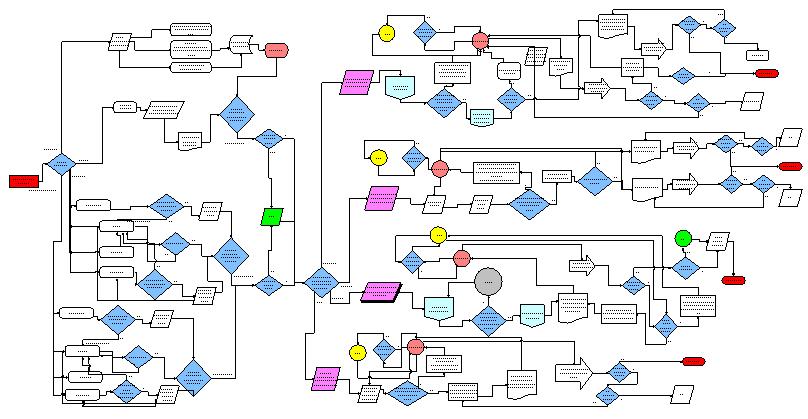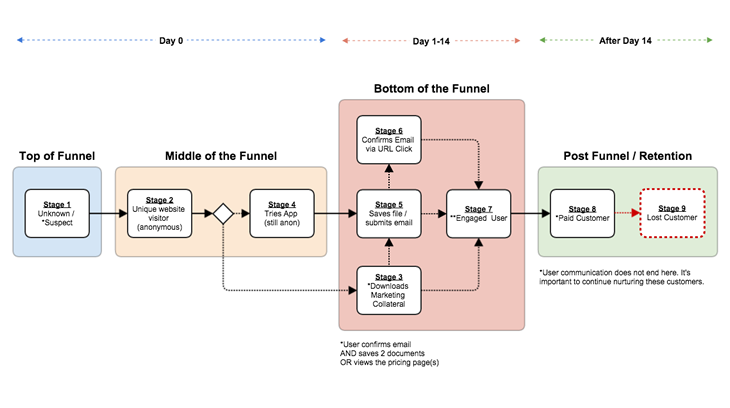We talk a lot about process mapping and process automation; how organizations can evaluate their processes, recognize those that can be improved, and optimizing them – in most cases, with the help of software – to make their business more efficient and less expensive.
We talk about this because, through our experiences, we know if things stay the status-quo, organizations are going to struggle to stay competitive.
In this guide to process mapping, we look at some of the formats and tools you can use to start mapping your processes and identifying areas where automation might be good for your business.
There are a few different formats that can be used to map a process, but before we start let us be clear on what each one does so you know which one to use.
Top down process map
This is a high-level look at what your process is achieving. It’s a good way to identify core hubs for a process, and strips the process right back to its ‘bare bones’.
What it’s good for
Top down process maps give you an initial overview of what a process is supposed to achieve. It can help define the scope of a project and can be a useful tool in solidifying a shared vision of the objective early on.
 Example of top-down process map, via
Example of top-down process map, via
How you do it
- List all the core hubs of a process. Limit this to 5-6 items.
- Put these hubs across the top of your page/screen/whiteboard.
- Underneath, list all various sub-steps that go into that particular hub. Again, 5-6 max.
Cross functional process maps - Swim lane maps
When most people think of a process map, this is what comes to mind. A cross-functional process map is a map that shows the relationship between various individuals or departments in a business and a process.
For example, if you were mapping customer acquisition, you might do a cross-functional map since the process involves marketing, sales, accounts, financials, etc.
Another example would be if you were looking at how to onboard new suppliers, you might use a cross-functional process map because the process would likely involve the relevant department, in addition to tasks along the way involving legal, procurement, and potentially the executive suite.
What it’s good for
Cross-functional process maps do a great job of showing how various aspects of business work together in a process and provide that essential bird’s eye view. Another way to put it is that the top down focuses only on the ‘what’ you’re hoping to achieve, and a cross-functional map focuses on the ‘what’ as well as the ‘who.’
 Example of a cross-functional process map, via
Example of a cross-functional process map, via
How you do it
- Identify a rep from every team you’re mapping and get them together in a room.
- Using a whiteboard, with the start of the process in the top left, list all the relevant stakeholders down the left-hand side in order of their proximity to the start. These are your swim lanes.
- Write each step for each stakeholder on Post-It notes and stick them on the whiteboard in their relevant swim lane. Do it chronologically so the first thing is on the left and the last thing on the right.
- Move the post notes around until everyone’s happy.
Detailed process map
The most detailed process map.
 Example of a detailed process map, via
Example of a detailed process map, via
What it’s good for
This is where you map out exactly what happens in a process. If we take our example above about onboarding a new supplier, one of the steps might be ‘due diligence’.
A detailed process map would then actually map out what that single Post it does.
This is the most in-depth and time-consuming process map to produce, but because of its granularity, it also offers the most opportunity to identify problems or inefficiencies.
How you do it
- Decide what process you’re mapping. This is the scope of the project.
- Start with a trigger for the process – what kicks the whole thing off? (e.g. ‘new order comes in online’)
- Sketch a cross-functional map first so you and your team get a loose idea of what happens when, or where in the broader business your small process takes place.
- Now, walk through your chosen process step by step, trying to distil each step down to a yes/no question for absolute clarity.
- Repeat this until the process is complete.
Tools to Build a Process Map
Those are the basic structures of process maps – but to formalize and distribute your beautiful maps, there are lots of tools out there to help you. Gliffy, for example, is a fantastic resource to get started mapping your processes.

A Gliffy flowchart
It allows you to create clean and clear process maps quickly and easily. With business-specific relationship shapes, you can even map our complex process in minutes.
This is enormously valuable to help you understand exactly what happens and when. Most managers and workers don’t see their entire process – Gliffy can help you get a bird’s eye view of what’s going on and what you can do to improve.
Since understanding what’s going on should be the first step in any business processing and automation project, Gliffy is a great tool to help you get started.
It’s free to try and use, but the full version is $3.99/month.
Summary
We’ve covered the three main types of process map that you’re likely to encounter and when to use each one.
Top down is great for getting a rough idea of what processes exist, and what they’re trying to achieve at a high level (e.g. drive sales, create customer experience – that sort of high level).
Cross-functional process maps help you by showing what goes where and who’s responsible. It also begins to map out when things have to happen, and will likely help you begin to spot potential bottlenecks.
As an added bonus, getting the team reps together to help map this process is likely to highlight misaligned ideas of what the process is. This is a great place to start the granular mapping process.
Finally, we covered the detailed process map, which is when you map out all the granular detail of a process by distilling each point down to a yes/no question.
